drupa in Düsseldorf:
melting pot of innovative technologies, solutions and knowledge-sharing
–The prime-time event for the global printing industry from 28 May to 07 June 2024
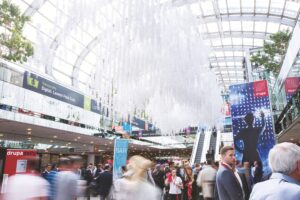 Over a period of eleven days, 1,625 exhibitors from 52 countries will present innovative technologies, solutions and topics that affect the industry now and in future. A wide range of special events will provide valuable know-how. There will be focus on digitalisation and sustainability.
Over a period of eleven days, 1,625 exhibitors from 52 countries will present innovative technologies, solutions and topics that affect the industry now and in future. A wide range of special events will provide valuable know-how. There will be focus on digitalisation and sustainability.
There’s a great deal of excitement in the international printing industry right now, as everyone will finally be able to meet up in person and exchange information at drupa, the world’s most important event for the sector, from 28 May to 07 June in Düsseldorf. In these very volatile times characterised by large social and also rapid technological changes and global megatrends, companies have to react: Those who do not anticipate important developments and adjust accordingly will endanger their competitive edge and waste opportunities for the future.
drupa is being held at just the right moment for this. In an international comparison, the leading global trade fair for print technologies both demonstrates the state of the industry’s art and a wide spectrum of innovations which will shape the future and offers a multitude of opportunities for high-calibre knowledge exchange, discussions and networking with word-renowned sector experts.
On a net area of approx. 140,000 m² with 18 show halls, 1,625 exhibitors from 52 countries will present the entire spectrum of current trends and visionary ideas within print technology. Production of packaging and printed packaging are two areas which have also significantly gained in importance. From renowned global players to aspiring newcomers and start-ups – the list of registered exhibitors is almost a who-is-who of the printing and packaging industry. Here is a small sample: Bobst, Canon, Comexi, Duplo, EFI, Epson, ESKO, Fujifilm, Heidelberg, Horizon, HP, Kodak, Koenig & Bauer, Kolbus, Komori, Konica Minolta, KURZ, Landa, Müller Martini, Ricoh, Screen, Windmöller & Hölscher, Xeikon.
drupa 2024 focus topics
Limited fossil resources and carbon emissions have caused sustainability to become an essential part of long-term company strategies. Depending on the use of resources, the print and packaging industries are already using manufacturing procedures that save energy and resources today. drupa explains the important facts for sustainable production of print and packaging solutions and which trends are evolving within the sector in order to achieve the goal of a circular economy.
Digitalisation is changing analogue processes, while artificial intelligence is taking on more and more tasks in Industry 4.0. drupa presents top technologies across the industry’s entire added value chain with a special focus on future and cross-sectional technologies. With this scenario in mind, topics like circular economy, automation, printing/finishing 4.0, artificial intelligence, platform economy and connectivity will be taking centre stage in the conference programme and expert forums.
Special forums
In times of constant change, disruptive processes and the resulting new business models, the drupa special forums are important aids for decision-making. They provide impetus and show best practices which the industry cannot do without. Together with its partners, drupa relies on its impressive range of competence across the industry and the topics which concern the future of its target groups.
drupa cube (Hall 6/Booth F03)
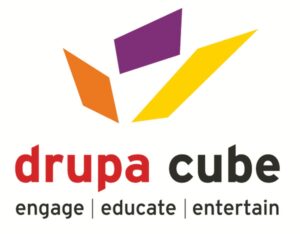 Why is printing more important than ever in the digital age? Why do customers not always perceive printed products as sustainable? And how do you calculate your carbon footprint? These are just some of the issues that will be discussed in the drupa cube in 2024. In more than 50 sessions, the conference offers inspiration and expertise. The programme features five great keynotes from renowned international industry specialists and presentations about topics like increasing your business success, circular economy and sustainability, the future of print and packaging as well as sessions and best practice examples regarding new business models and trends.
Why is printing more important than ever in the digital age? Why do customers not always perceive printed products as sustainable? And how do you calculate your carbon footprint? These are just some of the issues that will be discussed in the drupa cube in 2024. In more than 50 sessions, the conference offers inspiration and expertise. The programme features five great keynotes from renowned international industry specialists and presentations about topics like increasing your business success, circular economy and sustainability, the future of print and packaging as well as sessions and best practice examples regarding new business models and trends.
drupa touchpoint sustainability (Hall 14/Booth D60)
 touchpoint sustainability deals with the role of the printing and paper industries in sustainable transformation and offers an overview of current, mid- and long-term developments. Technologies from mechanical and systems engineering are especially important in this context, above all with regard to quality, process safety during production and sustainability. Digitalisation and AI play key parts
touchpoint sustainability deals with the role of the printing and paper industries in sustainable transformation and offers an overview of current, mid- and long-term developments. Technologies from mechanical and systems engineering are especially important in this context, above all with regard to quality, process safety during production and sustainability. Digitalisation and AI play key parts
in order to accelerate the transformation process in the print and paper industries and to realise scaling effects. Manufacturers, industry players, brands and users together show how change can become reality in their many exhibits at touchpoint sustainability. Visitors to touchpoint sustainability can also enjoy a broad accompanying programme.
drupa touchpoint packaging (Hall 3/Booth/B31)
 touchpoint packaging concentrates on visionary, intelligent packaging solutions and brings brand owners together with designers, print service providers and converters. The involvement of students and young talents in partner projects with exhibitors promises unique packaging solutions for folding boxes, labels, flexible packaging and corrugated cardboard. Beyond this, there will be discussion of important questions regarding global megatrends and their impact on packaging production, for example sustainability or e-commerce. The five key topics of touchpoint packaging are neo-ecology, connectivity, glocalisation, consumer mind and future regulations.
touchpoint packaging concentrates on visionary, intelligent packaging solutions and brings brand owners together with designers, print service providers and converters. The involvement of students and young talents in partner projects with exhibitors promises unique packaging solutions for folding boxes, labels, flexible packaging and corrugated cardboard. Beyond this, there will be discussion of important questions regarding global megatrends and their impact on packaging production, for example sustainability or e-commerce. The five key topics of touchpoint packaging are neo-ecology, connectivity, glocalisation, consumer mind and future regulations.
drupadna (Hall 7/Booth 09)
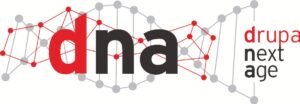 Big ideas, tiny budget – for many young companies, it’s not easy to make the right contacts and establish their fascinating and innovative solutions on the market. For this target group, drupa has created a special platform: drupa next age (dna). Newcomers, young talents, start-ups and established companies can network on a level playing field, find matching partners for cooperation and exchange innovative business ideas. For some participants, this is the first chance ever to present their businesses to an international audience of experts.
Big ideas, tiny budget – for many young companies, it’s not easy to make the right contacts and establish their fascinating and innovative solutions on the market. For this target group, drupa has created a special platform: drupa next age (dna). Newcomers, young talents, start-ups and established companies can network on a level playing field, find matching partners for cooperation and exchange innovative business ideas. For some participants, this is the first chance ever to present their businesses to an international audience of experts.
drupa touchpoint textile (Hall 4/Booth B30)
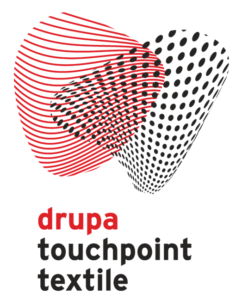 The drupa touchpoint textile presents the world’s first digital textile microfactory. This is a fully connected, integrated process chain – from digital simulation to design, animation and virtual rendering to production. One thing is sure: The industry is constantly gaining new fields of application, and inkjet technology not only opens doors to sectors like clothing and fashion, but also to the interior design, architecture, automotive and many other vertical markets.
The drupa touchpoint textile presents the world’s first digital textile microfactory. This is a fully connected, integrated process chain – from digital simulation to design, animation and virtual rendering to production. One thing is sure: The industry is constantly gaining new fields of application, and inkjet technology not only opens doors to sectors like clothing and fashion, but also to the interior design, architecture, automotive and many other vertical markets.
drupa Imaging Summit: The Importance of Artificial Intelligence for the Printing and Imaging Industry
At this year’s drupa, Messe Düsseldorf will present the drupa Imaging Summit for the first time as part of the “drupa next age” event series: Top-class speakers from renowned companies will give 20-minute keynote speeches and panels on the most important topics at the interface between imaging technologies and printing. This includes, in particular, the potential offered by the use of AI.
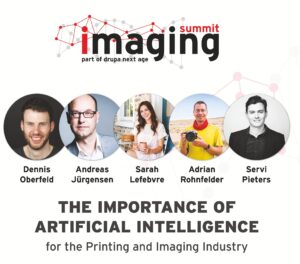 The imaging industry has come a long way in the last few decades. The shift to digital photography and workflows, and now the new big challenge of AI, are transforming the value creation of creators, companies and the industry. Along with many challenges, the new tools also create new opportunities and business areas.
The imaging industry has come a long way in the last few decades. The shift to digital photography and workflows, and now the new big challenge of AI, are transforming the value creation of creators, companies and the industry. Along with many challenges, the new tools also create new opportunities and business areas.
At the drupa Imaging Summit, one of the main themes will be the big trend topic of Imaging Artificial Intelligence, to learn about the current status and tools, discuss new product ideas and ways to enhance images for better prints.
Picture This: How Artificial Intelligence (AI) is Revolutionizing Image Creation (presented by Dennis Oberfeld, Google Cloud/Customer Engineer) shows how AI is supercharging the image creation process. The participants delve into Google’s powerful AI solutions, demonstrating how they streamline workflows and produce stunning results. Learn about upscaling, watermarking, and more – practical tools (not only) for print businesses and creatives alike.
Image generation via Artificial Intelligence: Tools & Workflows (presented by Andreas Jürgensen, Founder AI Imagelab | ai-imagelab.de) gives an overview of what is the current status of AI-generated images. Andreas Jürgensen gives a brief insight, which programs are currently relevant – and which ones you should keep an eye on, in which processes AI-generated images are currently being used and in which fields of application they are becoming relevant. The presentation will be illustrated with application and image examples.
AI Unveiled: Navigating Past, Present, and Future in Photo Print Innovation (presented by Sarah, Lefebvre, Director of Marketing at EyeQ Imaging Inc). The Creators of the leading Imaging Software, Perfectly Clear, show the remarkable advances AI has made in recent years as Sarah connects today’s applications of AI to real-world use cases and their impact on the printing industry. Be prepared to delve into the exciting possibilities of the future as she unravels the transformative impact of AI on photo printing.
The influence of Artificial Intelligence on future print products (presented by Adrian Rohnfelder, Founder AI Imagelab, ai-imagelab.de). In this highly illustrated and entertaining short presentation, Adrian Rohnfelder outlines possible print products of the future as a result of the new generative AI capabilities.
- Changes through AI support of existing products
- Key social media drivers such as pets and selfies for a flood of AI-generated images
- Possible consumer desires for 2D, 3D and 4D printing
Viesus: Prints enhanced in the blink of an AI (presented by Servi Pieters, CEO of Viesus) Dealing with thousands or even millions of images daily for printing? Do you often find these images lacking in quality or pixels? Are you facing lost time, complaints, and missed opportunities? Discover the behind-the-scenes algorithms used by leading names in the photo printing industry to minimize suboptimal prints. This talk reveals how AI algorithms improve image print production, delivering quality without the need for manual intervention.

